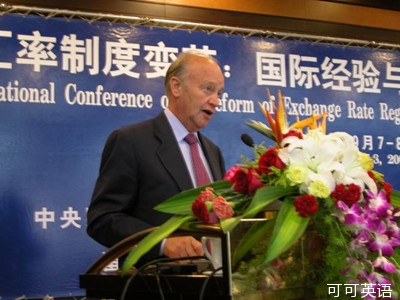China’s Growth: Why Less is More
中國(guó)的經(jīng)濟(jì)增長(zhǎng):為什么慢一些反而可能好?
October 29, 2013
2013 年10 月29 日
Less growth in China today will mean higher income in the future. So rather than worry, we should welcome the slowdown in China’s economy. Why? Because by favoring structural reforms over short-term stimulus, China’s leadership is illustrating their commitment to move to a more balanced and sustainable growth model.
中國(guó)目前經(jīng)濟(jì)增長(zhǎng)的減緩也許能帶來未來收入的提高。所以,對(duì)于中國(guó)經(jīng)濟(jì)增長(zhǎng)的減緩,我們不應(yīng)憂心忡忡,反而應(yīng)感到高興。為什么?因?yàn)橹袊?guó)領(lǐng)導(dǎo)人不再依賴短期刺激措施,而更傾向于實(shí)施結(jié)構(gòu)改革,這表明他們致力于使中國(guó)經(jīng)濟(jì)轉(zhuǎn)向更加平衡和更可持續(xù)的增長(zhǎng)模式。
Current model is not sustainable
當(dāng)前的模式不可持續(xù)
Borrow and spend, or in China’s case, borrow and invest works great to prop up growth. At least for a while. But eventually, debt rises, investment becomes less productive, and the risks rise.
借錢支出(中國(guó)是借錢投資)能夠極大地促進(jìn)經(jīng)濟(jì)增長(zhǎng)。至少在一定時(shí)間內(nèi)是這樣。但最終,債務(wù)將上升,投資效益將下降,風(fēng)險(xiǎn)會(huì)增加。
Fortunately, China’s economy still has considerable buffers. The risks to the outlook in the near-term, therefore, is extremely low. But the economy is becoming more vulnerable on several fronts: surging credit, strains on local government finances, and weakening balance sheets in parts of the corporate sector. Credit provides the clearest example. A broad measure of credit (total social financing) had held steady at about 130 percent of GDP for much of the 2000s. However, since 2008, it has shot up to around 200 percent of GDP: an increase of 70 percent of GDP in 4? years.
幸好中國(guó)經(jīng)濟(jì)仍有相當(dāng)大的緩沖空間。因此,近期經(jīng)濟(jì)前景面臨的風(fēng)險(xiǎn)非常低。但是,某些經(jīng)濟(jì)領(lǐng)域已開始變得較為脆弱:信貸激增,地方政府財(cái)政面臨壓力,一些企業(yè)的資產(chǎn)負(fù)債狀況在削弱。
信貸的例子最為明顯。在本世紀(jì)頭十年的大部分時(shí)間里,廣義信貸指標(biāo)(全社會(huì)融資總量)一直穩(wěn)定地保持在GDP的130%左右。然而,2008年以來,該指標(biāo)飆升至GDP的200%左右;在四年半的時(shí)間里,增幅達(dá)GDP的70%。
Not surprising, therefore, that investment is also booming. Investment accounts for nearly half of the economy’s output, which is among the highest in the world. Indeed, it is also high relative to the historical experience of other fast growing economies. As more output goes into investment, less goes into consumption. Indeed, in the past decade consumption’s share of output has declined significantly. Reversing this trend requires rebalancing growth away from investment and towards consumption.
因此,毫不奇怪,投資也出現(xiàn)了高漲情況。投資在經(jīng)濟(jì)產(chǎn)出中所占比例接近一半,從全球范圍看處于最高水平,即便與其他快速增長(zhǎng)的經(jīng)濟(jì)體的歷史經(jīng)歷相比也處于高位。
的確,過去十年里,產(chǎn)出中的消費(fèi)占比已顯著下降。為了扭轉(zhuǎn)這一趨勢(shì),需要降低經(jīng)濟(jì)增長(zhǎng)對(duì)投資的依賴,提高消費(fèi)的作用,從而實(shí)現(xiàn)再平衡。
More balanced and sustainable growth
更加平衡和可持續(xù)的增長(zhǎng)
Achieving more balanced and sustainable growth will hinge on implementation of a package of reforms. Let’s focus on two areas of the package: further strengthening of the financial sector and opening the service sector to more competition. Done together, these reforms could provide another one-two punch analogous to state enterprise reform in the late 1990s and joining the World Trade Organization, which propelled growth in the 2000s.
為了實(shí)現(xiàn)更加平衡和更可持續(xù)的增長(zhǎng),需要實(shí)施一攬子改革。我們主要來談?wù)勂渲袃身?xiàng)內(nèi)容:進(jìn)一步加強(qiáng)金融部門,以及增強(qiáng)服務(wù)行業(yè)的競(jìng)爭(zhēng)。這兩項(xiàng)改革合起來如同打出組合拳,效果類似于上世紀(jì)90年代后期的國(guó)有企業(yè)改革以及加入世界貿(mào)易組織。那兩項(xiàng)舉措推動(dòng)了本世紀(jì)頭十年的經(jīng)濟(jì)增長(zhǎng)。
A more market-based financial system will better channel household savings to productive uses. This means more credit to dynamic start-ups in the service sector—the type of firms currently squeezed out of the credit market. For this to work, the market for services needs to be more competitive, so these dynamic start-ups can actually start-up. Think healthcare, education, financial services, logistics, utilities, and telecom to name a handful. These new firms will, in turn, create jobs. And, the service sector tends to be more labor intensive than industry. More labor intensive growth means more household income, and higher household income means more consumption. Financial sector reform would also boost household income from investments directly. Bank deposits, where savings are often parked, have offered zero or often negative returns when adjusted for inflation. In a more market-based system, households would do much better than zero.
市場(chǎng)化程度更高的金融體系能夠更好地將居民儲(chǔ)蓄指引到有效益的領(lǐng)域。必須讓更多資金流入服務(wù)業(yè)的富有活力的新創(chuàng)企業(yè),而這類公司目前被排擠在信貸市場(chǎng)之外。為此,需要加強(qiáng)服務(wù)行業(yè)的競(jìng)爭(zhēng),從而使這些富有活力的新創(chuàng)企業(yè)能夠真正成長(zhǎng)起來。
醫(yī)療、教育、金融服務(wù)、物流、公用事業(yè)和電訊等行業(yè)都應(yīng)該進(jìn)一步改善。這些新的企業(yè)進(jìn)而會(huì)創(chuàng)造就業(yè)。此外,服務(wù)業(yè)往往比工業(yè)具有更高的勞動(dòng)密集度。勞動(dòng)密集度更高的經(jīng)濟(jì)增長(zhǎng)意味著更高的居民收入,而更高的居民收入意味著更多消費(fèi)。金融部門改革也能直接提高居民投資收入。目前居民儲(chǔ)蓄以銀行存款為主,考慮到通貨膨脹,存款收益為零甚至為負(fù)。在市場(chǎng)化程度更高的體系中,居民的投資收益應(yīng)該大大高于零。
Slower but better
更慢,但更好
There’s a catch: in this new model growth would be slower. In the coming years, taming rising risks in the economy—by reigning in credit growth and rationalizing investment—will likely slow the economy. Put simply, less stimulus means less growth. Reform itself could also entail adjustment costs in the transition, with some short run impact on growth.
有一點(diǎn)要注意:在這個(gè)新的模式下,經(jīng)濟(jì)增長(zhǎng)會(huì)減緩。今后若干年里,為了遏制經(jīng)濟(jì)中不斷上升的風(fēng)險(xiǎn),需要控制信貸增長(zhǎng),實(shí)現(xiàn)投資合理化,而這可能導(dǎo)致經(jīng)濟(jì)增長(zhǎng)減緩。簡(jiǎn)單來說,刺激的減少意味著增長(zhǎng)的放慢。改革本身也可能帶來過渡期間的調(diào)整成本,對(duì)經(jīng)濟(jì)增長(zhǎng)產(chǎn)生某些短期影響。
We estimate that with reforms China’s growth could average around 6 percent a year from now to 2030. By all measures—except perhaps China’s 10 percent average annual growth over the past 30 years—this would be a fantastic outcome. Especially when compared to a status-quo scenario, in which China could very well get stuck in the middle-income trap and income per person would peak at around 25 percent of that in the United States in 2030. In contrast, with successful reforms, income per person in China could reach 40 percent of the U.S. level by 2030.
我們估計(jì),從現(xiàn)在到2030年,在實(shí)施改革的情況下,中國(guó)經(jīng)濟(jì)平均每年將增長(zhǎng)6%。從所有衡量指標(biāo)來看(除了未能達(dá)到中國(guó)過去30年平均10%的年增長(zhǎng)率),這將都是一個(gè)了不起的結(jié)果。
特別是與維持現(xiàn)狀相比。如果維持現(xiàn)狀,中國(guó)很可能掉進(jìn)中等收入陷阱,到2030年,人均收入最高僅會(huì)達(dá)到美國(guó)的25%左右。相反,如果能夠成功實(shí)施改革,中國(guó)的人均收入到2030年可能達(dá)到美國(guó)的40%。
The new model would also deliver higher quality growth. Higher quality because it would improve living standards by boosting employment, income, and consumption; use less natural resources and be more environmentally friendly; and, most importantly, be sustainable.
新的模式還將帶來更高質(zhì)量的增長(zhǎng)。質(zhì)量更高,是因?yàn)檫@種增長(zhǎng)模式將促進(jìn)就業(yè)、收入和消費(fèi),從而提高生活水平;將使用更少的自然資源,更有利于環(huán)境;最重要的是,它將是可持續(xù)的。
Good for China and Good for the World
對(duì)中國(guó)好,對(duì)世界也好
Somewhat slower growth in the near-term is a tradeoff worth making for higher future income. This is clearly good not only for China, but also the world economy. By 2030 China—especially with successful reforms—will almost certainly be the world’s largest economy. So China’s success—which will substantially increase income in China—will also mean much higher global demand and will thus be hugely important for a robust and healthy global economy.
近期經(jīng)濟(jì)增長(zhǎng)有所減緩以換取未來更高的收入是值得付出的代價(jià)。顯然,這不僅有利于中國(guó),也有利于世界經(jīng)濟(jì)。到2030年,中國(guó)——特別是如果能夠成功實(shí)施改革的話——幾乎肯定會(huì)成為世界上最大的經(jīng)濟(jì)體。所以,中國(guó)的成功將顯著提高本國(guó)的收入,同時(shí)也會(huì)顯著增加全球需求,從而極大地促進(jìn)全球經(jīng)濟(jì)的強(qiáng)勁、健康發(fā)展。
Less growth in China today in exchange for more, much more, income in the future. So, less is indeed more.
中國(guó)當(dāng)前的增長(zhǎng)減緩將換來未來收入的顯著提高。所以,慢一些真的反而會(huì)更好。

更多精品翻譯素材,敬請(qǐng)關(guān)注可可英語。











